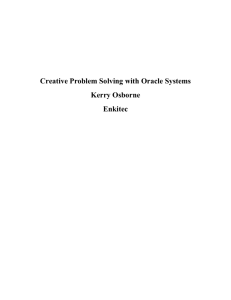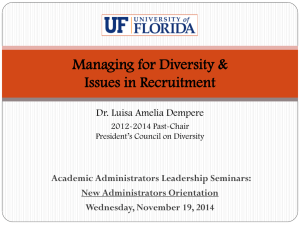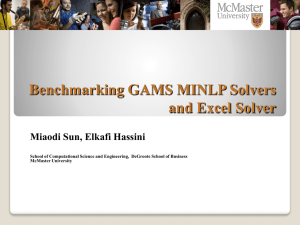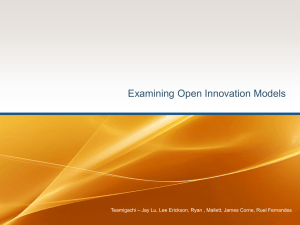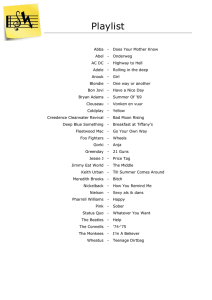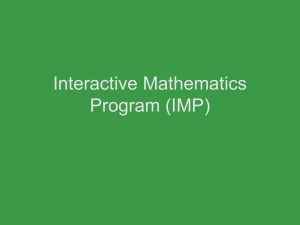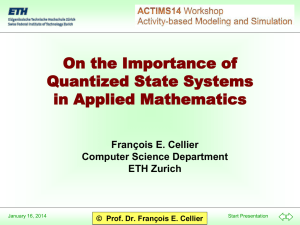Can Diversity Trump Ability? - North Carolina School of Science and
advertisement
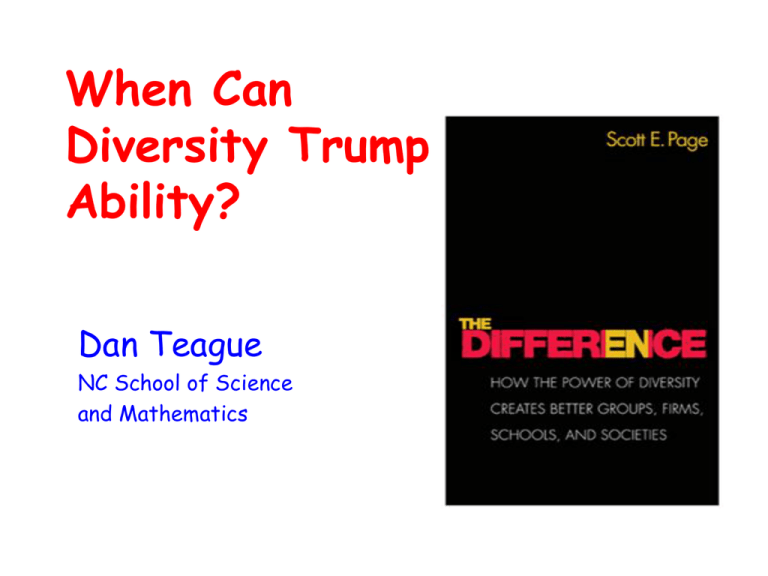
When Can Diversity Trump Ability? Dan Teague NC School of Science and Mathematics Scott Page, Lu Hong, John Miller Wisdom of the Crowd Information Aggregation On Who Wants to be a Millionaire, the lifeline is correct 2/3 of the time. The audience is correct 9/10 times! Identify the non-Monkee a) b) c) d) Peter Tork Michael Nesmith Roger Noll Davy Jones Crowd of 100 people • • • • 7 know all three of the Monkees listed 10 know two of the Monkees listed 15 know only one of the Monkees listed 68 know nothing about the Monkess What would the wisdom of the crowd show? The Vote • 7 know all three of the Monkees 7 votes for Roger Noll • 10 know two of the Monkees Expect 5 Votes for Roger Noll • 15 know only one of the Monkees Expect 5 Votes for Roger Noll • 68 know nothing about the Monkees Expect 17 Votes for Roger Noll 34 votes for Roger Noll Goldcorp Challenge In 1999 CEO Rob McEwen instructed his geologists to release all geological records to the public. The “Goldcorp Challenge” offered $575k to anyone who could find the gold and drew 1,200 people from 50 countries. Results: • 110 sites identified 50% new, 80% produced gold. • 8 million ounces found. • Company value up from $100 million to $9 billion. Galton’s Steer At the 1906 West of England Fat Stock and Poultry Exhibition, 787 people guessed the weight of a steer. Francis Galton collected the data and found the average guess was 1,197 pounds. The actual weight of the steer was 1,198 pounds. Accuracy of Group Predictions Computing the Squared Error (Variance) Computing the Crowd’s Diversity Diversity Prediction Theorem 38 = 39 - 1 In the case of Galton’s steer, the collective accuracy was approximately 1, the average accuracy was 2,956 and the diversity was 2,955. This means that individuals missed by about 55 or 60 pounds each. The fairgoers owe their collective accuracy more to their remarkable diversity than to the prescient individual abilities. When Diversity Matters • If Average Error is small, the task is easy. Diversity doesn’t help. • Group-think and deference to experts reduce the quality of the decisions. Cognitive Diversity Matters in Problem Solving Page Distinguishes: Diversity in Perspective Diversity in Heuristics Sum to Fifteen (Herb Simon, Nobel Prize in Econmics) One player randomly chosen to go first. Alternate turns selecting cards. The winner is the first player who has exactly 3 cards which sum to 15. Picnic Basket Game • • • • • • • • Nachos (N) Eggs (E) Sausage (S) Water (W) Hot Dogs (H) Vinegar (V) Lemons (L) Raisins (R) Goal is to Collect all 3 Copies of One Food Item Tic Tac Toe Perspectives • Trig functions If y = sin(x), is x a) an angle b) a distance around the unit circle c) a position on the real axis? • Coordinate Systems: Cartesian, Polar, Spherical • Functional representations: recursive, parametric, vector Mendeleyev’s Periodic Table Einstein and Bohr Every Tuesday from 3:00 to 4:00 in the afternoon, Niels Bohr and Albert Einstein would play duets together when they were both at Princeton. Einstein would play the violin and Bohr would play the piano. How would the history of science be different if Einstein had played the discrete instrument and Bohr the continuous instrument? Differing Perspectives Perspectives • When people see a problem from the same perspective, they are likely to get stuck on the same local peaks. • New perspectives can clarify or muddy. Sum to 15 can be seen as Tic Tac Toe or as the Unpacking Game. Heuristics • Process by which solutions are found within a perspective. Problem Solving Techniques. • Calculus • Do the Opposite (Castanza Rule Princeline.com) • Error Allowing Heuristics (Explore vs Exploit) Simulated Annealing (aka Brainstorming) IQ Test Question or 1+1=3 In each sequence, replace the X with the unique number that makes the sequence logically consistent. • Sequence 1: • Sequence 2: • Sequence 3: 1 4 9 16 X 36 1 2 3 5 X 13 1 2 6 X 1,806 • Sequence 1: 1 4 9 16 25 36 Square • Sequence 2: 1 2 3 5 8 13 Differences 1 2 3 5 • Sequence 3: 1 2 6 X 1,806 1+1 = 3 or maybe 4 Sequence 3: 1 2 6 X 1,806 42 Differences and Squares 2 – 1 = 12 6 – 2 = 22 X – 6 = 62 1,806 – X = 422 • Perspectives are ways of seeing the problem. They create different landscapes. • Heuristics are ways of constructing solutions. • The more productively a perspective organizes reality, the more heuristics people can create to work in that perspective. • Innovations can arise from rearranging the box with a new perspective or from exploring parts of the box that have been ignored with new heuristics. • Diverse perspectives are more likely to lead to breakthroughs; diverse heuristics are more likely to leader to iterative improvements. Multiple Perspectives and Heuristics are Essential We Now Work in Teams …and when working in teams… Selecting Talent (how we think about who’s good) Scores vs Toolkits Two Views of Ability Under what conditions does diversity trump ability? Page’s Initial Experiments Condition #1 “Calculus Condition” All Problem Solvers are Smart (relevant congnitive skills) All problem solvers can move the ball up or, at least, keep it at the same level. Condition #2 The Problem is Difficult No individual problem solver always locates the global optimum Condition #3 Diversity Any solution other than the global optimum is not a local optimum for some non-zero percentage of problem solvers. When one agent gets stuck, there is always another agent that can find an improvement using a different perspective or heurisitic. The intersection of all local max contains only the global max. Condition #4 Good-sized collections drawn at random from large population of potential problem solvers. The initial population of problem solvers must be large and the collections of problem solvers working together must contain more than a handful of problem solvers. Diversity Trumps Ability Theorem Given conditions 1-4, a randomly selected collection of problem solvers outperforms, on average, a collection of the best individual problem solvers. (in practice, a.s.) The Theorem The Basic Idea of the Proof Making a Difference: Applying the Logic of Diversity • The best problem solvers likely have similar perspectives and heuristics. The random problem solvers bring diverse ways of thinking. • The best problem solvers all get stuck at the same place. The random problems solvers don’t. • Academy of Mangement Perspecitves, Nov. 2007, page 11 Making a Difference: Applying the Logic of Diversity The best problem solvers likely have similar perspectives and heuristics. The random problem solvers bring diverse ways of thinking. The best problem solvers all get stuck at the same place. The random problems solvers don’t. Scott Page, from Academy of Mangement Perspecitves, Nov. 2007, page 11 Making a Difference: Applying the Logic of Diversity The logic of the theorem does not imply the irrelevance of ability. …Ability still matters, but so does diversity. And, as the theorem shows, once an ability threshold has been met, diversity matters more than ability. Scott Page, from Academy of Mangement Perspecitves, Nov. 2007, page 11 Problems of Diversity Communication (Problem solvers with diverse perspectives may have difficulty understanding each other) Misunderstanding and Mistrust Less comfortable atmosphere (We are all more comfortable with like-minded individuals If people do not believe in the value of diversity, then when part of a diverse team, they are not as likly to produce good outcomes.) Final Thoughts from Scott Page Our individual abilities are not likely to growth much anytime soon. Our collective diversity can grow. Diversity is our best hope to solve problems and to create innovations. References Scott Page, The Difference, Princeton University Press, 2007. Scott Page, Making the Difference: Applying a Logic of Diversity, Academy of Mangement Perspecitves, Nov. 2007. (Google Scott Page Academy of Mangement ) Lu Hong and Scott Page, Groups of diverse problem solvers can outperform groups of high-ability problem solvers , PNAS November 16, 2004 vol. 101 no. 46 16385–16389. (Google Hong and Page) Scott Page, Diversity and Complexity, Princeton University Press, 2011. John Miller and Scott Page, Complex Adaptive Systems, Princeton University Press, 2007.


